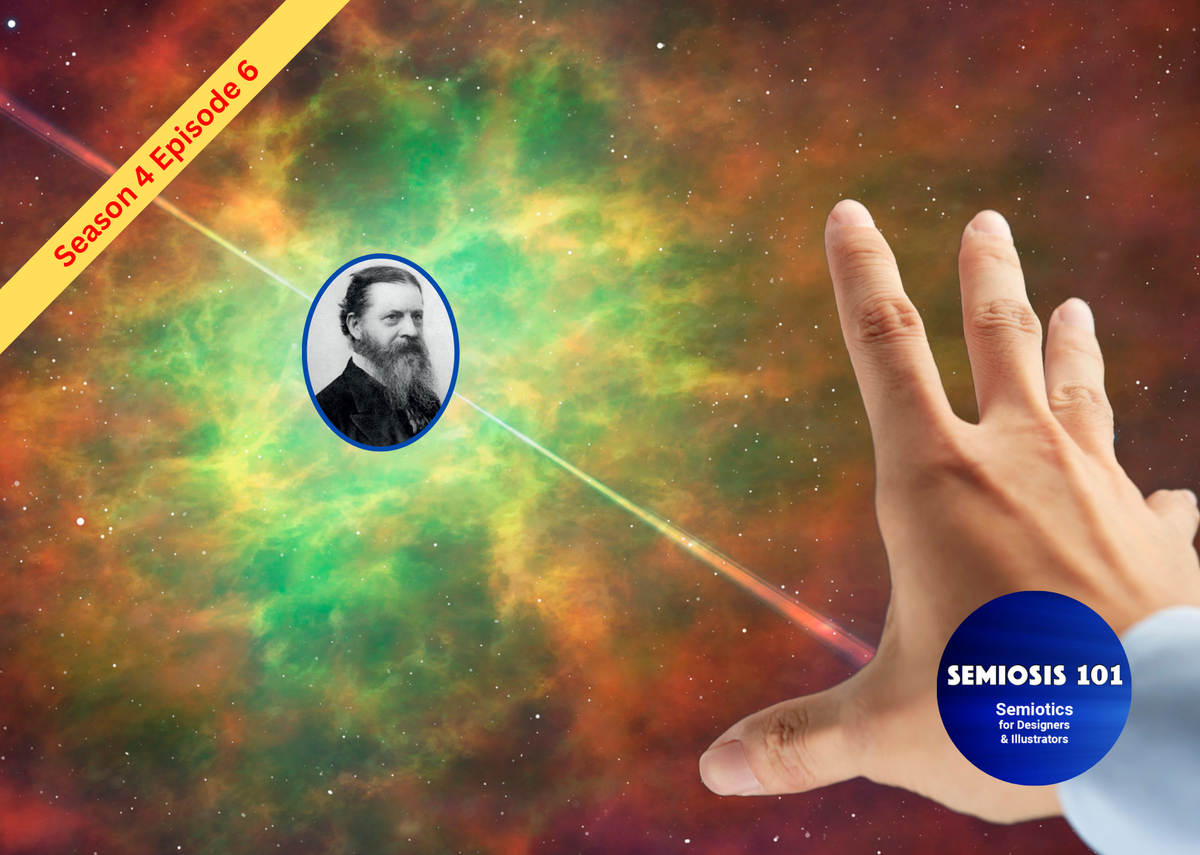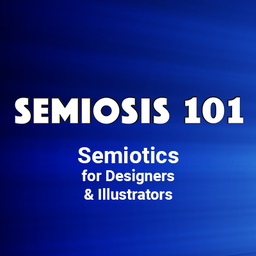Free Semiosis 101 Transcript 4.6:

How Can CREATIVES HELP Us to Visually Interpret Meaning?
Hello readers.
In this free transcript for the episode 4.6 published on Semiosis 101 on Weds 9th July 2025, we establish what we mean by “visual language” and how pragmatist aesthetics offers you illustrators and designers a fresh way to consider the visual part of communication. Semiotic signs are encoded meaning, built up from weak semiotic qualities. Semiotic sign-action is how the target audience interprets the representation of the concept you make. You creatives have the power to facilitate your audience’s perception…
Watch the free episode on YouTube for the full impact…
…and here is the episode’s transcript.
How Can CREATIVES HELP Us to Visually Interpret Meaning?
Let us examine enhancing your use of aesthetic visual language, eh?
With a micro adjustment to your semiotic awareness, you can enhance how you facilitate the visual hooking of your audience’s attention. Once your visual language has their attention, layers of semiotic signs can unlock levels of further meaning in your designs or illustrations. Shall we embrace some Semiosis then?
I use the term “visual language” a lot. So in this 6th episode of Semiosis 101’s season four, we establish what we mean by this term; and how pragmatist aesthetics offers you a fresh way to consider your visual part in communicating. I have always stated that semiotics is not a linear “How to…” process. Semiotic signs are not signage, so there is not a code book of signs that you can index and select an appropriate sign.
Semiotic signs are encoded meaning, built up from weak semiotic qualities. Semiotic sign-action is how the target audience interprets the representation of the concept you make. Perception is crucial to successful visual communication and your aesthetic just aids your audience to sense the encoded meaning. You creatives have the power to facilitate your audience’s perception.
Klaus Krippendorff, in his The Semantic Turn book, discusses sense in design.
“The quality of what we are immediately conscious (aware) of.”
“Sense is always someone’s sense. It is an embodied phenomenon.”
“Sense cannot be reduced to the physics of its triggers.”
I use triggering to describe how an audience begins to sense, perceive and interpret what a creative has semiotically encoded, into the visual language, of their aesthetic outcome. Semiosis is already in plain sight, encoded within the aesthetic. However, Semiosis remains semiotically dormant until the audience senses that what they are perceiving is meaning-bearing …in some way.
For the process of Semiosis to begin to unlock this encoded meaning in the mind of the audience, there is always a moment of not perceived before being perceived. Your aesthetic plays on their senses! I agree with Krippendorff that we cannot quantify sense. Nor can we quantify perception, or the triggering of a meaning-bearing semiotic sign.
While Krippendorff may not warm to Peirce’s semiotics, I have found Peirce’s three states of Firstness, Secondness and Thirdness a useful framework to semiotically ideate solutions. Peirce’s pragmatism utilises a mindset that has a phenomenological focus. These three states are a sense of flow. Just remember that we learn in design school to rely on our creative muscle-memory. Remember earlier I said Semiosis is not a linear “How-to” process too? Relax into the theory of Semiosis and absorb it naturally into your existing creative process as you ideate. Do not fret if “am I doing it right?”
Let us move forward beyond the terms into how Semiosis benefits your ideation and sketching. If you are relaxed we can now explore how your aesthetic’s visual language can semiotically retain your audience’s attention. This retention in their attention affords the audience more time to sense, perceive and interpret the intended meaning from how you have crafted the visual language. Remember, perceiving and interpreting may take milliseconds. Or encoded meaning may only be interpreted after multiple views.
What do I mean? How many views did it take you to perceive the arrow in the FedEx logo? Or perceive the smile in the Amazon logo? The arrow and smile were always in plain sight, yes?
Semiosis is helical and not linear. Semiosis, in the subconscious mind of the audience, cycles through concept > representation > interpretation > concept > representation… etc. in milliseconds. The audience’s interpretation begins once a familiarity to something is triggered. As a process of interpretation of the representation of a concept, the audience’s attention-span and lifeworld is how they understand your intended visually communicated meaning. Any aesthetic is not enough as “a thing of beauty” in itself. This is why a pragmatic framing of aesthetics helps you, as a creative, to understand the encoded semiotic power WITHIN your final aesthetic. In episode 4.5 we briefly explored the principles of aesthetics’ power emerging from its …USE. Check that out.
As creatives, this retention of attention is obviously desirable. After all we want our creative work to be appreciated. However, the retention of attention goes beyond personal creative egos. Retention of audience attention is what the client needs the creative to first achieve. Then the audience can interpret what they perceive. Semiotic sign-action is a transaction.
The visual language you designers and illustrators use in each commercial job, is where you can semiotically encode deeper meaning. Remember we are not concerned with denotational communication e.g. this IS this. I am focussing you onto how to craft the appropriate visual “tone of voice” to connect with your audience. The connotational communication of meaning e.g. this NOW MEANS THAT! This is sense-based communication. It is subtle by the visual facilitation of crafting the appropriate mood for the audience with the visual language.
The concept is whatever the client wants visually communicated from their brief. The concept is then semiotically delivered in three levels to the audience across three levels of Communication. The audience then perceive the representation and interpret it across three levels. These levels are Firstness, Secondness and Thirdness. Peirce’s Semiosis is based on the power of threes - triads.
In designer-centric terms, we can summarise these triads as:
Perception Power
possible (Rhematic) | suggested (Dicent) | resolved (Argument).
Communication Power
familiar (Iconic) | existent (Indexical) | proxy (Symbolic)
Delivery Power
instant (Qualisign) | mediated (Sinsign) | agreed (Legisign)
I append Peirce’s more obtuse terms to my designer-centric terms, to emphasise the need for Semiosis 101. If you want to read more about this then check out the Semiosis 101 Semiotic Resource on semiosis101.online. Link is below in the description.
How does this theoretical word soup help you illustrators and designers?
These three levels of three help evolve your creative mindsets to build into your aesthetic a consensus of meaning with your target audience. This will then help them to interpret. Let us not sweat over Pierce’s terminology. We can later return to Peirce’s obtuse terms. Instead, consider this statement.
There is always a moment when we did not know something before we knew something.
There is nothing philosophically profound about that statement. We can call this spontaneous moment the triggering of Semiosis. This subconscious level is when perception is formed by possiblities, representation by familiarities and semiotic delivery is instant. It is the moment when “not understanding” turns to “understanding.” When the audience’s perception switches from dormant to active. Perception activates the initial semiotic sign-action and interpretation. Then the next level is when perception is formed by suggestions, representation by existent things and semiotic delivery becomes mediated.
The highest level is when Perception is resolved, representation is by proxy and semiotic delivery is agreed. Or in Peirce’s terminology, the states of Firstness, Secondness and Thirdness. If we consider the semiotic delivery from simple to complex in designer-centric terms, meaning is delivered instantaneously, or mediated, or agreed. This refers to how the visual meaning is unlocked by the audience’s level of attention and exposure.
“Red” may suggest danger, but context, lived-experiences and socio-cultural agreements will lead the audience to an intended meaning. Perception of what is seen can be a possibility, or suggested, or resolved. “RED” is possibly a warning about something. It can strongly be suggestive of danger. Or we can resolve that when we see a red flag on a beach there are dangerous tides. Communication is by familiarity (Iconic), or existent (Indexical), or a proxy for (Symbolic). Let us see how semiotically manipulating these triads work.
In season three we explored semiotic manipulation in depth (watch omnibus 3.5). Encoding semiotic signs are built from weak qualities to strengthen higher level signs. To begin visually communicating at higher semiotic levels, the audience needs to be facilitated towards the interpretations they need to make. With a fresh semiotic mindset, you now understand that when you design or illustrate, you encode meaning to be triadically Perceived, Communicated and Delivered. The aesthetic choices you make to select appropriate visual language can be semiotically strengthened.
In the next episode we will look at a designed example to explore how this semiotically works. Subscribe to be notified when this is published. Or become a Semiosis 101 Producer on Patreon and watch all Semiosis 101 episodes months ahead of YouTube …and receive other exclusive Patreon-only content.
Hint… hint…
Semiosis 101 Semiotic Design Resources is a reader-supported publication. To receive exclusive posts and support my work, consider becoming a free or paid subscriber. Paid subscribers get name checked on all future Semiosis 101 YouTube episodes.
===Semiosis 101 Patreon Producer==============
Become a Semiosis 101 Patreon Producer and get a named producer credit on future video episodes, plus watch all new episodes months ahead of YouTube.
===Semiosis 101 Patreon Exclusives==============
Watch longer Patreon-exclusive Semiosis 101 episodes on applying Semiosis into design and illustration…
PATEXC001 How does semiotics work in illustration?





